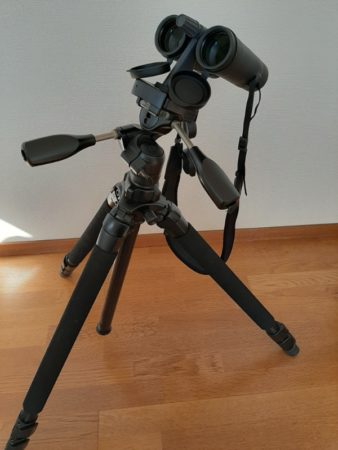As an astronomy enthusiast, in my 20’s I would often drive, searching for dark skies. In those days, I always carried my Nikon 10×70SP binoculars with a tripod, which gave me a fantastic image. It felt as if I were in the Millennium Falcon, looking at the Andromeda Galaxy through the round window.
The optical design of that pair is excellent for sure, but the tripod enabled me to get a much more amazing view without any shakiness. A tripod is necessary for giant binoculars with apertures over 70mm because of their weight.
However, we sometimes want to mount regular binoculars on a tripod for various reasons. For example, if you want to keep watching a birds’ nest for a long time, or if you’re going to show a nebula to someone who has no idea where to look, a tripod is helpful.
In this article, I will show you how to mount your binoculars on a tripod, which should enhance the image considerably.
Contents
How to attach a binocular tripod mount adapter
First, you’ll need to check whether your binoculars have a tripod socket cover (see below).

The most common type is a screw thread adapter, which is designed to screw into the threaded socket. This part is usually covered with a dust cap.

You can buy tripod mount adapters on the Internet, but some types may not fit your binoculars. An important point is how much space there is between the barrels (see below).

If the adapter is too large, it won’t fit. You should make sure to get the right adapter for your pair of binoculars.

The adapter is designed to attach to a tripod head mounting plate.

The grip should be facing away from you so that it won’t get in the way when you look through the eyepieces.
Next, you should know that there are other types of tripod mount adapters. For example, Nikon has its own adapter which attaches to the central shaft.

https://shop.nikon-image.com/front/ProductBAB90004?cid=JDEAX408278&gclid=Cj0KCQiAmsrxBRDaARIsANyiD1ogi2oc9RcaqihfWTvI1dgPczYBnKMMMhqmz90KnIMN9JVvKaQQFk0aAiQrEALw_wcB
This type works well on binoculars with an exposed central shaft. If there is not an exposed shaft, like many compact binoculars, it won’t work.

Finally, if your pair doesn’t have a threaded socket or an exposed central shaft, don’t give up. For such binoculars, there’s a universal type of adapter that can hold the barrels tight with a belt design (see below).

https://www.kyoei-osaka.jp/SHOP/leica-tripod-adapter.html
A quality tripod is required for large binoculars.
No matter how firmly binoculars are tightened to the tripod, if the tripod is not well made, your binoculars could fall. In the darkness, astronomers often bump a leg of the tripod.
As your binoculars get larger and heavier, you’ll need a sturdier one. A poorly made tripod cannot get rid of the image shake completely, especially when it’s windy. There is no point in using a badly made tripod. Experienced astronomers know that a quality mount can cost as much as a telescope.

Pro-tip on improving a tripod’s stability: If you have a bag with strings, put something heavy inside and hang it from the legs to make the tripod more stable (see above).
Enjoy the steady image!
Mounting binoculars on a tripod enables you to get a much clearer image. For example, if you hold your binoculars with your hands and look at a cluster of stars, you might only see the brightest stars in the group.
But, with a tripod, so many of the dimmer stars will appear, which will probably give you goosebumps. It’s hard to realize how much is missed by the image shake until you mount your binoculars onto a tripod.
Also, if you want to enjoy stargazing with children, a tripod can help you share the view with them. No matter how much you tell them where to look, they often won’t be able to find celestial objects because they are too dim. But, with a tripod, once you aim it, they can enjoy the same image that you see.
Summary
We sometimes need to mount binoculars on a tripod to get rid of the image shake. All you need to do is buy a tripod adapter. But you should be careful because there are different types of tripod adapters.
The most common type is designed to screw into the binoculars threaded socket. Some adapters won’t fit because there is not enough space between the barrels.
Nikon sells a different type of adapter, which attaches to the binoculars exposed central shaft.
If your binoculars don’t have a threaded socket or a central shaft, I recommend you get a universal type of adapter. This is designed to hold binoculars steady with a belt design.
Remember to use a sturdy, well-made tripod so that your binoculars don’t fall. This is especially important for big astronomical binoculars.
Having a shake-free image will give you such a better view. You’ll also be able to share that clear view with a friend.
